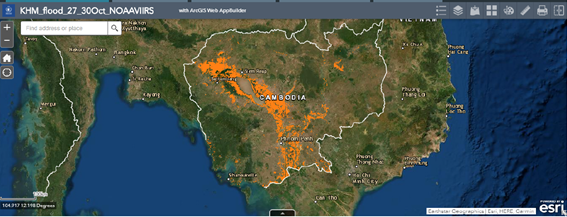Ms. Lara Prades
Head, Geospatial Support Unit, Emergency Division (EMEG)
Mr. Michael Andrew Manalili
GIS Consultant, Geospatial Support Unit, EMEG
United Nations World Food Programme (WFP)
United Nations World Food Programme (WFP) is the newest member of Sentinel Asia. They have already provided their support for Sentinel Asia as a Data Analysis Node, or DAN, for the Emergency Observation Request (EOR) for the flood in Cambodia in October 2020. They are also a Nobel Peace Prize laureate 2020. Sentinel Asia secretariat had an opportunity to interview them to introduce this new member.
Sentinel Asia Secretariat
WFP joined Sentinel Asia as a Data Analysis Node in September 2020. Please tell us what motivated WFP to join Sentinel Asia.
WFP
WFP is motivated to join Sentinel Asia for many reasons. Our primary goal is to extend WFP’s network and partnership with the space-based organization to provide analytics and geospatial products to support WFP operations in Asia.
Sentinel Asia is a vital resource for us because most of the most vulnerable countries to climate and weather-related shocks are in the region and WFP has an extensive presence in Asia. In fact, WFP highly appreciates Sentinel Asia by utilizing a vast network to provide satellite images from member states and organizations. Having access to this excellent network allows WFP to extend our geospatial capabilities in providing geospatial support to the region.
Sentinel Asia Secretariat
Could you tell us the mission of WFP as a whole and the WFP Emergency Division (EMEG), respectively?
WFP
The overall mission of WFP is to eradicate hunger and malnutrition worldwide. Every day, WFP and its partners work to bring us closer to a “zero hunger” world. Meanwhile, our complimentary programmes address the root cause of hunger, building the resilience of communities, so we don’t need to keep saving the same lives each year.
The role of the Emergency Operations Division (EMEG) is to convene and steer WFP in emergency operations. Our main goal is to support WFP operations across functions at the regional and country level. We ensure WFP has a skilled emergency workforce ready to deploy, and we work with the humanitarian community and key actors to identify places and people in most need, using innovative methods, including geospatial technology.
Sentinel Asia Secretariat
How does satellite data contribute to the WFP EMEG’s missions? It would be helpful and motivating for Sentinel Asia members if you could give us some specific examples of use.
WFP
Satellite data has been very instrumental to WFP’s operation in many ways by allowing the organization to see the bigger picture during an emergency. Not only it allows WFP to see the disaster itself, but it also allows WFP to understand the local condition on the ground for better preparedness and planning. We use satellite data to: assess impact of disasters during floods, earthquakes, and conflict, to correlate food security condition on the ground on social and environmental conditions, we use satellite imagery to visualize conflict areas, understand cropping pattern for livelihood assessment and ultimately for damage assessment and monitoring in an event of Emergency Data derived from satellite images when added to other reference geospatial data provides substantial information to the colleagues on the ground in a form of maps, web maps, mobile applications, dashboards, analytics and automated system critical for emergency preparedness and response.
Sentinel Asia Secretariat
Speaking of your activities, the Nobel Peace Award 2020 has been awarded to WFP. The Sentinel Asia community heartily expresses congratulations to WFP. Could you tell us which activities of yours do you think were recognized?
WFP
The 2020 Nobel Peace Prize awarded to the United Nations World Food Programme is recognition of the important link between conflict and hunger and the critical role that food assistance plays in supporting the first step towards peace and stability. To name an example of WFP’s activities, with the Emergency Operations Division’s crucial support, under the COVID-19 surge, in order to meet the increased operational needs while also supporting the humanitarian and health community, WFP deployed over 500 staff to 71 different countries despite all the travel restrictions in place.
I think that WFP is an incredibly special place to work with and the Nobel Prize has been very well received, and we are immensely proud of, but it was completely unexpected. The main reason of this award was our role of food assistance to build peace and stability.
Also, the way to the Nobel prize was connected to what we are doing as always – it is “bridging gaps related with food supply”. If there is a conflict, people cannot access to food, so we have to solve it by using food assistance. The logistic people always say, “It is not the problem of food, but it is about the problem of bringing the food.”
Sentinel Asia Secretariat
In this regard, in the context of the Sentinel Asia activity, right after you joined Sentinel Asia, you supported the EOR for the flood in Cambodia in October, which had caused a potential threat for agriculture and food supply. You have generated and provided a product, for which we are grateful. Could you share with us WFP’s aspirations for the future activities in Sentinel Asia?
WFP
our mission of eradicating hunger. Partnership and collaboration are primary WFP’s strengths, as they allow us to bridge the gap between science and product operationalization from research, technology, and innovation.

The first product provided to Sentinel Asia by WFP